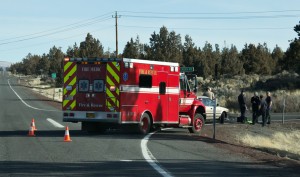Driving is part of nearly every call, and medical emergencies do not stop happening on account of bad driving conditions. When winter rolls around, most people can leave the car in the garage and stay off the roads. As an EMT you don’t have that luxury, and there are certain precautions and considerations to take. Here are some tips on how to stay safe on the road as a paramedic, from keeping the vehicle in good condition to reducing your speed.
At the station
When the temperatures are dropping and you hear that first winter forecast of the season, preparing your vehicle should be your first move. If you drive a vehicle that belongs to a department, the tires are usually well maintained, and the tread depth should be sufficient for winter driving. Even so, it certainly doesn’t hurt to check. If you are a volunteer, then it is your responsibility to check the inflation and tread depth of the tires on your vehicle.
Check that you have the appropriate level of fluids that are specifically meant to combat freezing temperature, namely antifreeze. Also, your windshield wiper fluid should be rated not to freeze, so make sure you’ve got enough. You’d hate to be flying blind out there.
Speaking of your windshield wipers and your windshield, make sure your wiper blades are soft, pliable and in good condition. Visibility is greatly reduced in inclement weather, so remember to clean your windows and windshield thoroughly between calls. Ice, snow and salt can all accumulate over time, so make sure that your headlights and emergency lights are cleared off. This ensures other motorists can see you when you’re rushing to respond. Snow and ice can also pack into your siren cones, so clear those out to make sure your siren is at full volume.
On the road
Getting your vehicle properly prepared to face the harsh environment in the event of a call is only half the battle. The rest takes place when you’re actually driving, and a main factor is ice. You don’t always see ice, so an important thing to do when you’re responding to a call is to reduce your speed and increase your stopping distance. You may tend to ignore your speed while focusing to respond as fast as possible, but you may be putting yourself and other motorists in danger.
Black ice can show up anywhere; so remember that just because you can see the road does not mean it is free of ice. Remember that bridges and overpasses freeze before the rest of the road does, so be especially careful when your route takes you over one. Ice isn’t always the culprit in winter driving, so watch out for snow and slush as well. Snow and slush make roads slippery, and you can get stuck in particularly deep snow. Don’t drive into deep snow unless you are driving a vehicle that is adequately suited for it.
Above all, be careful! With a proactive attitude and an awareness of road conditions, you’ll be able to carefully and quickly respond to any emergency calls during the winter.
Author Bio:
Cheryl Bikowski is Marketing Communications Supervisor of Gamber-Johnson in Stevens Point, WI. Gamber-Johnson is a leading supplier of vehicle computer mounts and vehicle docking stations and is a member of the Leggett & Platt Commercial Vehicle Products (CVP) Group.
- California Casualty Earns Financial Stability Rating® of A, Exceptional, From Demotech, Inc. - April 28, 2025
- Music & Arts Grant Recipients – 2024 - December 13, 2024
- Understanding Auto and Home Insurance Rate Changes - December 3, 2024

